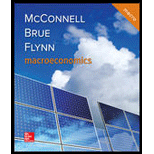
Subpart (a):
Market demand .
Given information:
| Price per candy | Individual quantity demanded | Total quantity demanded | ||
| ‘T’ | ‘D’ | ‘R | ||
| 8 | 3 | 1 | 0 | - |
| 7 | 8 | 2 | - | 12 |
| 6 | - | 3 | 4 | 19 |
| 5 | 17 | 6 | 27 | |
| 4 | 23 | 5 | 80 | - |
Subpart (a):
Explanation of Solution
When the price is $8, the total quantity demanded can be calculated as follows:
Thus, the value of the total quantity demanded when the price $8 is 4 units.
When the price is $7, ‘R’ individual quantity demanded can be calculated as follows:
Thus, the value of ‘R’ individual quantity demanded is 2 units.
When the price is $6, ‘T’ individual quantity demanded can be calculated as follows:
Thus, the value of ‘T’ individual quantity demanded is 12.
When the price is $5, ‘D’ individual quantity demanded can be calculated as follows:
Thus, the value of ‘D’ individual quantity demanded is 4.
When the price is $4, the total quantity demanded can be calculated as follows:
Thus, the value of the total quantity demanded is 36.
Concept introduction:
Market demand: Market demand refers to the sum of all individual quantities demanded.
Subpart (b):
Market demand.
Given information:
| Price per candy | Individual quantity demanded | Total quantity demanded | ||
| ‘T’ | ‘D’ | ‘R | ||
| 8 | 3 | 1 | 0 | - |
| 7 | 8 | 2 | - | 12 |
| 6 | - | 3 | 4 | 19 |
| 5 | 17 | 6 | 27 | |
| 4 | 23 | 5 | 80 | - |
Subpart (b):
Explanation of Solution
When the price per candy is $5, then ‘D’ the least amount of quantity demanded is 4, ‘T’ demand is 17 and ‘R’ demand is 6.
When the price per candy is $7, then ‘T’ the least amount of quantity demand is 8, ‘D’ demand is 2 and ‘R’ demand is 2.
Concept introduction:
Market demand: Market demand refers to the sum of all individual quantities demanded.
Subpart (c):
Market demand.
Given information:
| Price per candy | Individual quantity demanded | Total quantity demanded | ||
| ‘T’ | ‘D’ | ‘R | ||
| 8 | 3 | 1 | 0 | - |
| 7 | 8 | 2 | - | 12 |
| 6 | - | 3 | 4 | 19 |
| 5 | 17 | 6 | 27 | |
| 4 | 23 | 5 | 80 | - |
Subpart (c):
Explanation of Solution
When the price of candy decreases from $7 to $6, then ‘T’ the demand increases by
Concept introduction:
Market demand: Market demand refers to the sum of all individual quantities demanded.
Subpart (d):
Market demand.
Given information:
| Price per candy | Individual quantity demanded | Total quantity demanded | ||
| ‘T’ | ‘D’ | ‘R | ||
| 8 | 3 | 1 | 0 | - |
| 7 | 8 | 2 | - | 12 |
| 6 | - | 3 | 4 | 19 |
| 5 | 17 | 6 | 27 | |
| 4 | 23 | 5 | 80 | - |
Subpart (d):
Explanation of Solution
When ‘T’ withdraws from the market, then there is less demand at each price level and it shifts the demand curve to the left.
If ‘D’ doubles his purchase at each price level, then it increases the demand and it shifts the demand curve to the right.
Concept introduction:
Market demand: Market demand refers to the sum of all individual quantities demanded.
Subpart (e):
Market demand.
Given information:
| Price per candy | Individual quantity demanded | Total quantity demanded | ||
| ‘T’ | ‘D’ | ‘R | ||
| 8 | 3 | 1 | 0 | - |
| 7 | 8 | 2 | - | 12 |
| 6 | - | 3 | 4 | 19 |
| 5 | 17 | 6 | 27 | |
| 4 | 23 | 5 | 80 | - |
Subpart (e):
Explanation of Solution
If the price is fixed at $6 and the total quantity demanded increases from 19 to 38, then it changes the demand that results in the change in price.
Concept introduction:
Market demand: Market demand refers to the sum of all individual quantities demanded.
Want to see more full solutions like this?
Chapter 3 Solutions
Macroeconomics
 Exploring EconomicsEconomicsISBN:9781544336329Author:Robert L. SextonPublisher:SAGE Publications, Inc
Exploring EconomicsEconomicsISBN:9781544336329Author:Robert L. SextonPublisher:SAGE Publications, Inc Managerial Economics: A Problem Solving ApproachEconomicsISBN:9781337106665Author:Luke M. Froeb, Brian T. McCann, Michael R. Ward, Mike ShorPublisher:Cengage Learning
Managerial Economics: A Problem Solving ApproachEconomicsISBN:9781337106665Author:Luke M. Froeb, Brian T. McCann, Michael R. Ward, Mike ShorPublisher:Cengage Learning Principles of MicroeconomicsEconomicsISBN:9781305156050Author:N. Gregory MankiwPublisher:Cengage Learning
Principles of MicroeconomicsEconomicsISBN:9781305156050Author:N. Gregory MankiwPublisher:Cengage Learning Principles of Microeconomics (MindTap Course List)EconomicsISBN:9781305971493Author:N. Gregory MankiwPublisher:Cengage Learning
Principles of Microeconomics (MindTap Course List)EconomicsISBN:9781305971493Author:N. Gregory MankiwPublisher:Cengage Learning Principles of Economics, 7th Edition (MindTap Cou...EconomicsISBN:9781285165875Author:N. Gregory MankiwPublisher:Cengage Learning
Principles of Economics, 7th Edition (MindTap Cou...EconomicsISBN:9781285165875Author:N. Gregory MankiwPublisher:Cengage Learning Essentials of Economics (MindTap Course List)EconomicsISBN:9781337091992Author:N. Gregory MankiwPublisher:Cengage Learning
Essentials of Economics (MindTap Course List)EconomicsISBN:9781337091992Author:N. Gregory MankiwPublisher:Cengage Learning





